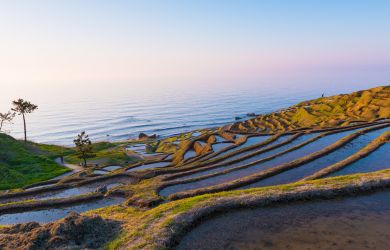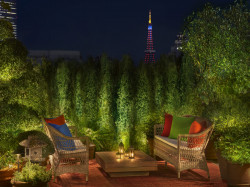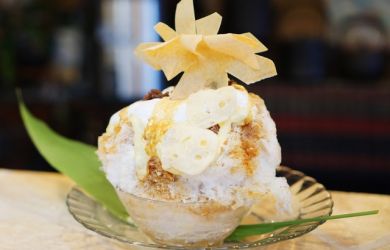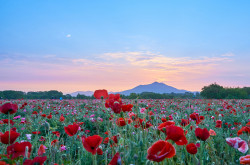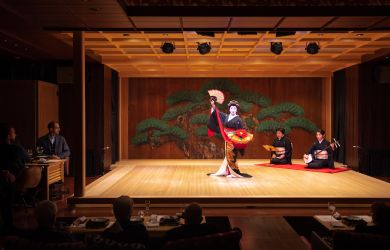
May 12, 2006
Just A Castaway
Hidden messages and burnt-out Tokyoites wash up on Okinawa’s islands
By Metropolis
Originally published on metropolis.co.jp on May 2006

Photos by Simon Rowe
The sea throws up many a strange thing. Now and again amateur beachcombers strike it lucky: a matching pair of sneakers, a rubber duck that still squeaks, or even an antique glass fishing buoy, the kind that Japanese fishermen once used but these days swing on beach bungalow verandas from Australia’s Cape Tribulation to California’s Monterey.
Or unlucky, as was a man named Ishii-san, who I meet in the southern Okinawa Islands. He says he found several hundred rubber sandals washed up on the shore near his house one morning, only to discover on closer inspection that they were all left-footers.
Ocean currents that pass through Okinawa, like the Kuro-shio, or Black Current, act as huge conveyor belts for the flotsam and jetsam of Southeast Asia’s seaboard dwellers. This explains the international nature of junk strewn along shorelines such as those on Haemida Beach on the 284km2 Iriomote-jima. Located more than 1,800km south of Tokyo, Iriomote-jima is home to roughly 2,000 sugar cane farmers and fisherfolk.

In just 30 minutes of beachcombing along Haemida’s wide arc of golden sand, I find M&Ms tubes made in Ohio, medicine bottles with Chinese inscriptions, motor oil canisters from Manila, shampoo bottles with labels in Korean hangul, a child-sized Reebok sneaker, a toy cow, a baseball, a cigarette lighter made in Bangkok, and dozens upon dozens of egg-shaped fishing buoys.
On a humid May afternoon, with storm clouds threatening overhead, I set out along the jungly high-tide mark of Haemida’s northern coves, dodging caravan-sized chunks of volcanic rock that have broken loose and now lie strangled on the beach by vines and wild flowers.
At the mouth of one tiny cove, a chopstick lying in the sand catches my eye, then a piece of half-eaten custard fruit, a flashlight bulb and a razor. The trail leads into a sea cave where candle wax drips from the walls and a blackened fireplace points to recent human habitation.
Fishermen? Smugglers? A North Korean agent? Haemida is keeping its secrets.
Further along, the inlets narrow and I’m forced to wade waist-deep between beaches. It is here in one of these less-easily accessed coves, among layers of sea junk and steaming clumps of seaweed, that I find the beachcomber’s greatest prize of all: a message in a bottle.
“Air Minum Sulawesi” (“Sulawesi Drinking Water”) reads the label, in Indonesian. From out of the taped-up plastic bottle I gently coax a damp, cigar-sized roll of paper. The date reads September 2000, and below this, six lines of scrawled handwriting convey a simple message in not-so-simple Chinese.
“Probably a bored Taiwanese fisherman with nothing better to do than toss messages overboard,” says Yamamoto-san, a weathered, chain-smoking 40-something who runs his own sea kayak touring business, who I meet on my way back to Iriomote’s languid port of Ohara. “This kind of thing turns up now and again.”
He calls himself Papillon—French for “butterfly”—and his little finger is missing below the first knuckle, which usually implies some affiliation with the yakuza. I remind myself not to ask him where he keeps his petty cash.
Yamamoto’s comments are backed up in Ohara. “Not mainland Chinese” is the verdict from the row of red-eyed cane cutters sipping awamori rice wine at the counter of the local bar. “This message was written by a Taiwanese, or someone from Hong Kong,” says one.
Due to their close proximity, the Okinawa Islands have always had a close affiliation with Taiwan, and some suggested that I try the marketplace on nearby Ishigaki-jima, an island where many Taiwanese have settled over the centuries. Yet amid the piles of vegetables and tropical fruit of Ishigaki’s morning market the next day, not one of the elderly women with scowling faces and severe makeup can make out more than the last line of the message: “Thank you.”

Reading my disappointed expression, one of them whisks me off to a clothing shop, where an elderly Taiwanese woman is shelling peanuts. She looks at me and squints through her half-rims at the ragged piece of paper, reading it slowly:
Dear Brother….
Please contact a broadcasting station if my letter is caught in your line while you are fishing. [The next line, she says, makes some reference to money]. Thank you.
It is sometimes possible to stumble on “human messages” in the Okinawa Islands. They regularly wash up in the form of disillusioned (and sometimes disoriented) urban escapees, like “Michael” Takano from Tokyo, who I meet on my return to Haemida Beach a week later. He has come to this same beach more than 80 times to purge himself, he says, of the “big city blues.”
With a tent and a small kayak, he tells me he can stay for months at a time, spearing and cooking reef fish, buying rice from a local country store, and camping on his farmer friend’s land. “Ii-neeee,” he says, scanning the mountains, beach and sea devoid of all human existence.
He then asks for my notepad and pencil and proceeds to draw a small and rather eclectic picture of a bald-headed monk with two sleeping dogs on each side. Beneath this he scribbles four kanji characters.
“Who’s that?” I ask.
“It is you,” he replies.
“What about those kanji?”
He gives me the grin of man who has also purged himself of life’s mundane chores, like cleaning one’s teeth.
“It means ‘One Day, One Life’.”
Ishigaki-jima is located in the extreme southwest of Okinawa Prefecture. Direct flights run from Tokyo, take 3hrs, 25min and cost ¥20,000-¥60,000, depending on the season. Try the English-speaking www.japan-saver.com, based in Tokyo, for discounted fares. The best time to visit is spring for the cool nights and warm days and summer for hotter weather and marine sports. Swimming is possible year-round. For atmosphere, try Guesthouse Rakutenya, where English is spoken (tel: 0980-83-8713). It’s a 10min walk from Ishigaki City port and 10min by taxi from the airport. On Taketomi-jima, Takana Ryokan (tel: 0980-85-2151/ fax: 0980-85-2129) is highly recommended for its home-cooked dishes. Meals are included in the tariff, ¥8,000 per person. Many restaurants and local eateries serve cheap and authentic Yaeyama cuisine throughout the islands. Try Ma-sando (tel: 0980-83-4050), located on Shiyakusho Street behind the port. Look for the giant red lantern outside.
[geo_mashup_map]
